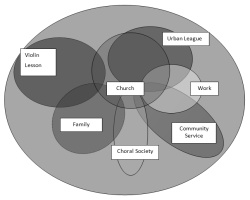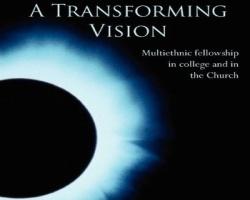A common ministry model of participation can be pictured in terms of concentric circles. The center circle denotes maximum participation. A person in the outermost circle may have simply expressed interest in the fellowship by signing a form during orientation, attending an event or friendship with a member. A person slightly closer to the center may attend a large group meeting or small group occasionally. Movement toward the center involves regular small group and large group attendance and may include membership in a high-commitment small group, praise team leadership, conference attendance, participation in a short-term missions project, and being part of the executive leadership team. A person generally takes on additional responsibilities and commitments as he or she moves towards the center.
Rather than a model that encourages people to hit the concentric circle bull’s-eye, we need a model that not only allows, but even encourages, involvement in multiple spheres. I find it helpful to think in terms of ellipses of involvement.
 This is a much messier diagram than the concentric circle model. However, it more accurately reflects how people experience life and ministry. An ellipse is an oblong with two fixed points or foci. The two foci have a major axis connecting them, like a subway line between two destinations. A man comes to a church leaders’ meeting. He then returns to his home to take his son to his violin lesson. The next day he goes to work, drops by church to meet with the pastor and then goes to an Urban League meeting. On the weekend, he spends time on a Habitat for Humanity build, goes home to make dinner with his wife, and they attend a special missions conference at church. Real life requires constant traversing between multiple points. The ellipses of involvement model recognizes the complexity of life and the responsibility for the fellowship to help its members live godly lives in light of all of those various foci.
This is a much messier diagram than the concentric circle model. However, it more accurately reflects how people experience life and ministry. An ellipse is an oblong with two fixed points or foci. The two foci have a major axis connecting them, like a subway line between two destinations. A man comes to a church leaders’ meeting. He then returns to his home to take his son to his violin lesson. The next day he goes to work, drops by church to meet with the pastor and then goes to an Urban League meeting. On the weekend, he spends time on a Habitat for Humanity build, goes home to make dinner with his wife, and they attend a special missions conference at church. Real life requires constant traversing between multiple points. The ellipses of involvement model recognizes the complexity of life and the responsibility for the fellowship to help its members live godly lives in light of all of those various foci.
The church should not be a place that supports the bifurcation of life, but its integration. Life in the kingdom of God is all-encompassing. It is not divided into my Christian activities and my other activities. Being a disciple of Jesus involves all that we do, not only those activities done within the confines of formal fellowship structures, in accordance with Paul’s instructions in Colossians: “And whatever you do, whether in word or deed, do it all in the name of the Lord Jesus, giving thanks to God the Father through him” (
The various commitments that the members of a multiethnic fellowship have should be objects of prayer, support, and, where helpful, training. The community of faith must live with a conscious awareness of what happens outside of its own particular activities, for these too are places for kingdom work.
Adapted with permission from A Transforming Vision: Multiethnic Fellowship in College and in the Church by Paul Sorrentino (IVP). The book is available at leading book stores including Amazon.
Related Articles:
Why Do I Care About Racial Reconciliation?
Moved to Action
White People Worship?
Where Everyone Is Uncomfortable, and that’s OK
Leading a Multiethnic Fellowship
Multiethnic Worship
A Case for Continuing Monoethnic Minority Fellowships




